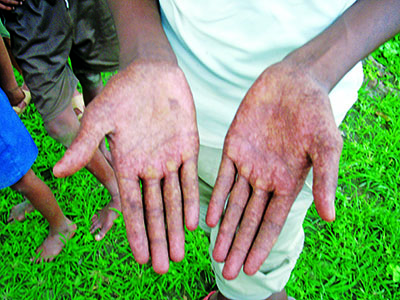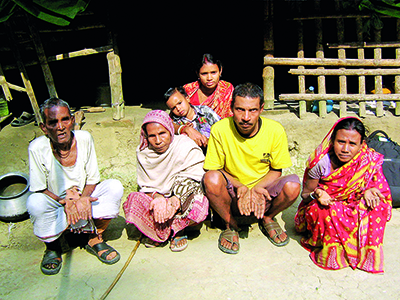
Saurabh Singh explains to villagers what the spots on their hands mean
With Arsenic creeping up, a helping hand in villages
Civil Society News, New Delhi
Even as temperatures soar in the north, making it necessary to stay indoors, a small band of healthcare activists has been setting out each day in the blazing sun to help rehabilitate people afflicted with arsenic poisoning in villages of eastern Uttar Pradesh.
The Inner Voice Foundation’s small team has reached out to 50 villages and perhaps 50,000 people so far this summer, says Saurabh Singh, who leads the organization and describes himself as a homegrown arsenic mitigation expert.
Helping arsenic victims manage their condition is particularly important in summer, Singh explains, because arsenic concentration in groundwater increases, often exponentially, as a result of a falling water table. People drink the water they get and when there are extremely high levels of arsenic it worsens their condition.
Arsenic creeps its way into the body with a build-up taking place over time. It manifests in changes in skin pigmentation and sores on the palms and soles. It also becomes visible on the back and chest.
But by the time arsenic’s telltale marks show up, a lot of harm has already been done. There is damage to the liver and kidneys. It is also the cause of many cancers. Helping people manage their condition therefore becomes important so that they suffer less and perhaps survive longer.
“Of the more than 50,000 patients who turned up at our camps, perhaps 70 percent had arsenic induced diseases, including cancer,” says Singh. “After rehabilitation they can live a little longer. We have witnessed this in many districts in the past 20 years.”
| Kolkata finally sees arsenic.... September-October 2012. CLICK HERE |
What does rehabilitation involve? It begins with awareness. Most people don’t realize that the arsenic is entering their bodies through the water they drink. So, the first thing is to make them aware and then identify water sources in a village that have low or acceptable levels of arsenic. People can then drink water only from those sources. They are also taught the importance of including protein and fruits in their meals. It is also a good thing to walk or exercise to the extent possible. People who do a lot of physical labour are less prone to arsenic build-up in their bodies.
 |
|
Arsenic spots on the hands |
“There is no known cure and no medicine for arsenic poisoning. Only lifestyle changes are possible and for advanced cases that can only bring some relief,” says Singh. “We are working in villages where arsenic contamination is very high. Our biggest strength is that we can identify patients and do their rehabilitation.”
“Till June 10 we have organized rehabilitation camps in villages around Allahabad, Mirzapur, Chandauli, Varanasi, Ghazipur, Mau and Bhadohi. We will next be going to villages in other districts of Uttar Pradesh and Bihar,” he says.
Arsenic awareness and mitigation have largely been a lost cause despite the fact that it potentially puts at risk the health of millions. Singh was groomed by Dr Dipankar Chakrabarti who was hounded first by the Left and then the Trinamool government in West Bengal for raising the issue of arsenic in drinking water.
 |
|
Four generations of a family affected by arsenic |
Dr Chakrabarti, who was a dynamic scientist and the head of the School of Environmental Sciences before his death, fought hard for arsenic in water to be recognized as a serious public health hazard. It is because of his efforts that today it is finally recognized as such. But governments remain slow to act with preventive measures.
“We can do diagnosis and rehabilitation on our own thanks to Dr Chakrabarti and Dr R.N. Dutta who had a long association with our team,” says Singh. “We need support for this campaign.”
Activist groups like the Inner Voice Foundation run by Singh happen to be around and make a difference. But it is a drop in the ocean. It is from the government that the big push must really come. Mere recognition of the problem is not enough. A public health effort to scale needs to be rolled out. Primary health centres need to be activated.
Arsenic occurs naturally in underground geological structures and is widely present across the Gangetic basin in eastern Uttar Pradesh, Bihar and West Bengal. It is also to be found in Bangladesh.
Overuse of underground water leads to arsenic leaching into aquifers and getting consumed by villagers when the water is pumped up. The summer months are particularly bad because, with groundwater levels falling, the concentration of arsenic increases. ν
Comments
Currently there are no Comments. Be first to write a comment!





